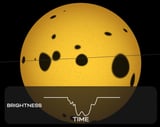New Model Enhances Star Spot Mapping, Boosts Exoplanet Atmosphere Studies
August 25, 2025
Scientists have developed a new model called StarryStarryProcess that maps star spots on distant stars by analyzing light curves from NASA's TESS and Kepler missions, improving our understanding of stellar surface features and their influence on exoplanet studies.
This model enhances traditional methods by incorporating star rotation data, allowing for detailed insights into the number, location, and brightness of star spots, which are similar to sunspots but change over time.
Star spots are cool, dark patches on stellar surfaces that impact the analysis of transiting exoplanets and the determination of their properties, making accurate mapping essential for astrophysics.
Part of NASA’s Astrophysics Pioneers Program, the Pandora mission aims to study exoplanet atmospheres and stellar activity to better interpret signals from missions like Webb, especially in multiwavelength observations.
Pandora will utilize tools like the StarryStarryProcess model to improve the analysis of exoplanet atmospheres by accounting for stellar activity, which is crucial for identifying indicators such as water vapor.
Enhanced star spot mapping can help distinguish stellar signals from planetary signals, aiding in the detection of exoplanet atmospheres and assessing their habitability, particularly with upcoming missions like NASA's Pandora.
Understanding stellar surface activity is vital for accurately interpreting exoplanet data, and while the current model is limited to visible light, future applications will include infrared observations from missions like Webb.
The model's future will benefit from upcoming observations from NASA’s Pandora mission, which will help analyze exoplanet atmospheres and star activity more effectively.
Testing of the model on the exoplanet TOI 3884 b, a gas giant 141 light-years away, revealed that its host star, TOI 3884, has concentrations of star spots at its north pole.
Analysis of the star TOI 3884, a cool star located about 141 light-years away, confirmed the presence of spot concentrations at its north pole, which are transited by the planet TOI 3884b from our perspective.
Summary based on 2 sources
Get a daily email with more Science stories
Sources

Phys.org • Aug 25, 2025
Astronomers map star spots using Tess and Kepler
NASA Science • Aug 25, 2025
Astronomers Map Stellar ‘Polka Dots’ Using NASA’s TESS, Kepler - NASA Science